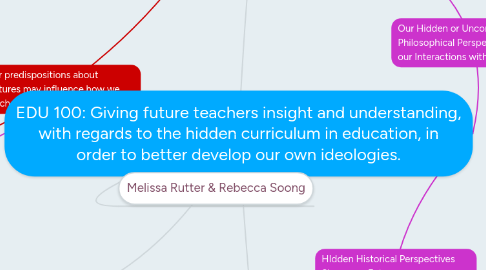
1. Melissa Rutter & Rebecca Soong
2. Philosophical
2.1. What is education?
2.1.1. "Learning is a lifelong endeavor, and every question and problem in a university classroom has influences from ones current life history, within and outside of the formal modern education system" (Anuik, 2012, CP p.3).
2.2. Teacher Identity
2.2.1. In the "Let's Count: Learning Numbers in Various Ways" video, teacher Rosemary Kungu was able to use different teaching strategies to utilize whole-child learning (TeachingChannel.Org).
2.2.1.1. We feel that teacher Kungu showed us how whole-child learning is an important part when developing teaching strategies and subsequently our own ideologies.
2.3. Teaching Philosophy
2.3.1. Dr. Gleddie an elementary teacher, proposed his own philosophy on how a teacher is able to create meaningful relationships with students. (Dr. Gleddie).
2.3.1.1. We felt that he showed how meaningful relationships with students can facilitate their learning when in a non-threatening environment.
2.3.2. "Your beliefs and predispositions about teaching and education have a profound impact on how you teach and what you teach, just as your beliefs and predispositions about living have a profound impact on how you live your life" (Martin & Loomis, 2006, p. 38-67).
2.3.2.1. Through further research Rebecca found that she agreed with the progressivist and existentialist teaching philosophies.
2.3.2.2. Melissa found that she agreed with the progressivist teaching philosophy.
2.3.2.2.1. "Education should be students rather than content and whatever is taught should be meaningful; education is to prepare students to be lifelong learners in an ever-changing society" (Martin & Loomis, 2006, p. 38-67).
2.3.2.3. We feel because our underlying beliefs are not always present or conscious, yet influence our teaching they can be considered hidden curriculum when developing our own ideologies.
2.4. Overall our own philosophies shape how we view our students, how we view teaching and ultimately how we will teach and interact with our students.
3. Historical
3.1. Overall we must remember our past to move forward. While the past may be hidden in the curriculum, it is important that we are sensitive to the children of past generations who will be attending our classes and may still be haunted by previous generations experiences.
3.2. "Eugenics was a social movement [between] 1865 - 1945" in Alberta; it aimed to improve the quality of human populations by changing the kinds of people there were intergenerationally" (GS: Rob Wilson).
3.2.1. We feel eugenics is important to teachers today because of its impact on individuals with disability. Classifying students by their ability undermines their autonomy and we need to be cognizant of the fact that we as teachers should not be classifying disability in the classroom.
3.2.1.1. We think that students with disability know their strengths and limitations with regards to what they can and cannot do better than anyone else. So therefore teachers should not make the assumption that some individual students are less capable than others.
3.2.1.2. We also feel that teachers should consult with individual students about what their needs are and how those needs should specifically be met.
3.3. From class we discussed the impact of residential schools on Aboriginal students in the 20th century. We learned that the lasting effects of these schools have been detrimental to Aboriginal communities. The schools undermined their culture and intelligence forcing them to adopt Euro-centric views.
3.3.1. We feel that we need to therefore be sensitive to the fact that many of our Aboriginal students may have come from homes that have carried this burden with them throughout generations.
3.4. "Parents of First Nations students on reserves express the fear that their children are failing to develop a positive sense of their identity and that curricula rarely reflects their children’s true history, diverse cultures and languages and their contributions to Canada" (Laboucane, 2010).
4. Sociological
4.1. Education and Diversity
4.1.1. "Are we all equal Canadian citizens or are some always identified as "Asian" while others are "white"?" (Cui & Kelly, 2012, CP p. 185).
4.1.1.1. We feel that this notion does not just apply to Asian students it can also apply to other cultural minority groups that identify one way or the other.
4.1.1.2. We think that stereotyping of students by cultural identity greatly limits their educational experiences if they are for example always pushed by teachers to go into subjects like science and math. Again showing the hidden curriculum that teacher's may not be aware of.
4.1.2. We think that creating safe spaces in schools for LGBTQ students is of up-most importance.
4.1.3. "Understand our rights and responsibilities as educators in relation to LGBTQ inclusion" (Malinda McNie – Institute for Sexual Minorities Studies and Services).
4.1.4. "The issue of homophobia - a pervasive form of bullying - tends to be absent from public discussion, anti-bullying programs, and so-called safe schools policies" (Walton, 2004, p. 23).
4.1.4.1. We all know that bullying in schools is inevitable, however the types of bullying such as homophobia may not be on the forefront of our minds.
4.1.4.1.1. We feel as future educators, we need to be aware of the incidence of homophobic bullying and do everything in our power to prevent it.
